Effect of Silane-Containing Universal Adhesives on the Bonding Strength of Lithium Disilicate
Abstract
:1. Introduction
2. Materials and Methods
2.1. Specimen Preparation
2.2. Etching, Silanization, and Bonding Procedure
2.3. Microtensile Bond Strength (μTBS) Test
2.4. Analysis of Failure Mode
2.5. Microscopic Observation of Bonded Interfaces
2.6. Statistical Analysis
3. Results
3.1. μTBS
3.2. Analysis of Failure Mode
3.3. FE-SEM Evaluation
4. Discussion
5. Conclusions
- HF improved the bonding strength between lithium disilicate and resin regardless of the silane treatment.
- For all the experimental groups that were treated with silane separately, the bonding strength between lithium disilicate and resin was improved.
- The silane in universal adhesives did not effectively improve the bonding strength between lithium disilicate and resin cement, and the silane-containing universal adhesives were not more effective than the non-silane-containing universal adhesives in improving the bonding strength between lithium disilicate and resin cement.
Author Contributions
Funding
Institutional Review Board Statement
Informed Consent Statement
Data Availability Statement
Conflicts of Interest
References
- Murillo-Gómez, F.; Rueggeberg, F.; De Goes, M. Short- and long-term bond strength between resin cement and glass-ceramic using a silane- containing universal adhesive. Oper. Dent. 2017, 42, 514–525. [Google Scholar] [CrossRef]
- Sundfeld Neto, D.; Naves, L.; Costa, A.; Correr, A.; Consani, S.; Borges, G.; Correr-Sobrinho, L. The effect of hydrofluoric acid concentration on the bond strength and morphology of the surface and interface of glass ceramics to a resin cement. Oper. Dent. 2015, 40, 470–479. [Google Scholar] [CrossRef] [PubMed] [Green Version]
- Cardenas, A.M.; Siqueira, F.; Hass, V. Effect of MDP-containing silane and adhesive used alone or in combination on the long-term bond strength and chemical interaction with lithium disilicate ceramics. J. Adhes. Dent. 2017, 19, 203–212. [Google Scholar] [PubMed]
- Yao, C.; Zhou, L.; Yang, H.; Wang, Y.; Sun, H.; Guo, J.; Huang, C. Effect of silane pretreatment on the immediate bonding of universal adhesives to computer-aided design/computer-aided manufacturing lithium disilicate glass ceramics. Eur. J. Oral Sci. 2017, 125, 173–180. [Google Scholar] [CrossRef]
- Lee, H.Y.; Han, G.J.; Chang, J.; Son, H.H. Bonding of the silane containing multi-mode universal adhesive for lithium disilicate ceramics. Restor. Dent. Endod. 2017, 42, 95–104. [Google Scholar] [CrossRef]
- Puppin-Rontani, J.; Sundfeld, D.; Puppin-Rontani, R.; Costa, A.; Correr, A.; Borges, G.; Sinhoreti, M.; Correr-Sobrinho, L. HF concentration and etching times on lithium disilicate glass-ceramic. Oper. Dent. 2016, 42, 606–615. [Google Scholar] [CrossRef]
- Kalavacharla, V.K.; Lawson, N.C.; Ramp, L.C.; Burgess, J.O. Influence of etching protocol and silane treatment with a universal adhesive on lithium disilicate bond strength. Oper. Dent. 2015, 40, 372–378. [Google Scholar] [CrossRef] [PubMed] [Green Version]
- Tian, T.; Tsoi, J.K.; Matinlinna, J.P.; Burro, M.F. Aspects of bonding between resin luting cements and glass ceramic materials. Dent. Mater. 2014, 30, e147–e162. [Google Scholar] [CrossRef]
- Pisani-Proenca, J.; Erhardt, M.C.G.; Valandro, L.F.; Gutierrez-Aceves, G.; Bolanos-Carmona, M.V.; Castillo-Salmeron, R.D.; Bottino, M.A. Influence of ceramic surface conditioning and resin cements on microtensile bond strength to a glass ceramic. J. Prosthet. Dent. 2006, 96, 412–417. [Google Scholar] [CrossRef]
- Şişmanoğlu, S.; Gürcan, A.T.; Yıldırım-Bilmez, Z.; Turunç-Oğuzman, R.; Gümüştaş, B. Effect of surface treatments and universal adhesive application on the microshear bond strength of CAD/CAM materials. J. Adv. Prosthodont. 2020, 12, 22–32. [Google Scholar] [CrossRef] [PubMed] [Green Version]
- Melo, L.D.; Moura, I.S.; Almeida, E.D.; Junior, A.F.; Dias, T.D.S.; Leite, F.P. Efficacy of prostheses bonding using silane incorporated to universal adhesives or applied separately: A d review. J. Indian Prosthodont. Soc. 2019, 19, 3–8. [Google Scholar] [CrossRef]
- Chen, L.; Shen, H.; Suh, B.I. Effect of incorporating BisGMA resin on the bonding properties of silane and zirconia primers. J. Indian Prosthodont. Soc. 2013, 110, 402–407. [Google Scholar] [CrossRef]
- Yoshihara, K.; Nagaoka, N.; Sonoda, A.; Maruo, Y.; Makita, Y.; Okihara, T.; Irie, M.; Yoshida, Y.; Van Meerbeek, B. Effectiveness and stability of silane coupling agent incorporated in ‘universal’ adhesives. Dent. Mater. 2016, 32, 1218–1225. [Google Scholar] [CrossRef] [PubMed] [Green Version]
- Lung, C.Y.K.; Matinlinna, J.P. Aspects of silane coupling agents and surface conditioning in dentistry: An overview. Dent. Mater. 2012, 28, 467–477. [Google Scholar] [CrossRef]
- Colares, R.C.R.; Neri, J.R.; Souza, A.M.B.D.; Pontes, K.M.D.F.; Mendonca, J.S.; Santiago, S.L. Effect of surface pretreatments on the microtensile bond strength of lithium-disilicate ceramic repaired with composite resin. Braz. Dent. J. 2013, 24, 349–352. [Google Scholar] [CrossRef] [PubMed]
- Guarda, G.B.; Correr, A.; Goncalves, L.; Costa, A.; Borges, G.; Sinhoreti, M.; Correr-Sobrinho, L. Effects of surface treatments, thermocycling, and cyclic loading on the bond strength of a resin cement bonded to a lithium disilicate glass ceramic. Oper. Dent. 2013, 38, 208–217. [Google Scholar] [CrossRef] [PubMed] [Green Version]
- Kursoglu, P.; Motro, P.F.K.; Yurdaguven, H. Shear bond strength of resin cement to an acid etched and a laser irradiated ceramic surface. J. Adv. Prosthodont. 2013, 5, 98–103. [Google Scholar] [CrossRef] [PubMed] [Green Version]
- Nagai, T.; Kawamoto, Y.; Kakehashi, Y.; Matsumura, H. Adhesive bonding of a lithium disilicate ceramic material with resin-based luting agents. J. Oral Rehabil. 2005, 32, 598–605. [Google Scholar] [CrossRef] [PubMed]
- Panah, F.G.; Rezai, S.M.M.; Ahmadian, L. The influence of ceramic surface treatments on the micro-shear bond strength of composite resin to IPS Empress 2. J. Prosthodont. 2008, 17, 409–414. [Google Scholar] [CrossRef] [PubMed]
- Mohamed, M.M.; Albedaiwi, L.; Almahdy, A.; Khan, R.; Silikas, N.; Hatamleh, M.M.; Alkhtani, F.M.; Alrahlah, A. Effect of universal adhesives on microtensile bond strength to hybrid ceramic. BMC Oral Health 2019, 19, 178. [Google Scholar]
- Maier, M.; Bordihn, V.; Belli, R.; Taschner, M.; Petschelt, A.; Lohbauer, U.; Zorzin, J. New approaches in bonding to glass-ceramic: Self-etch glass-ceramic primer and universal adhesives. J. Adhes. Dent. 2019, 21, 209–217. [Google Scholar] [PubMed]
- Yao, C.; Yu, J.; Wang, Y.; Tang, C.; Huang, C. Acidic pH weakens the bonding effectiveness of silane contained in universal adhesives. Dent. Mater. 2018, 34, 809–818. [Google Scholar] [CrossRef] [PubMed]
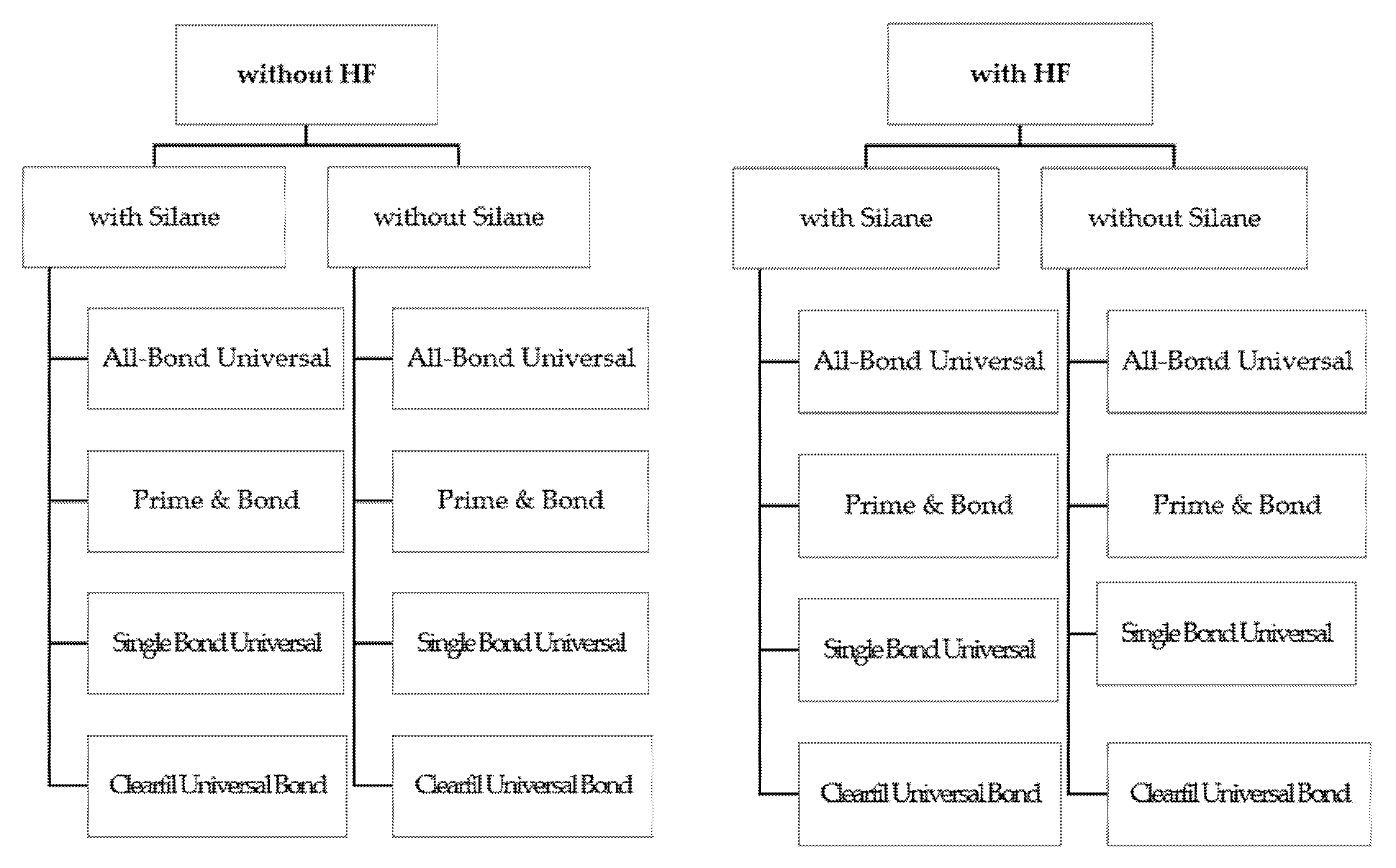
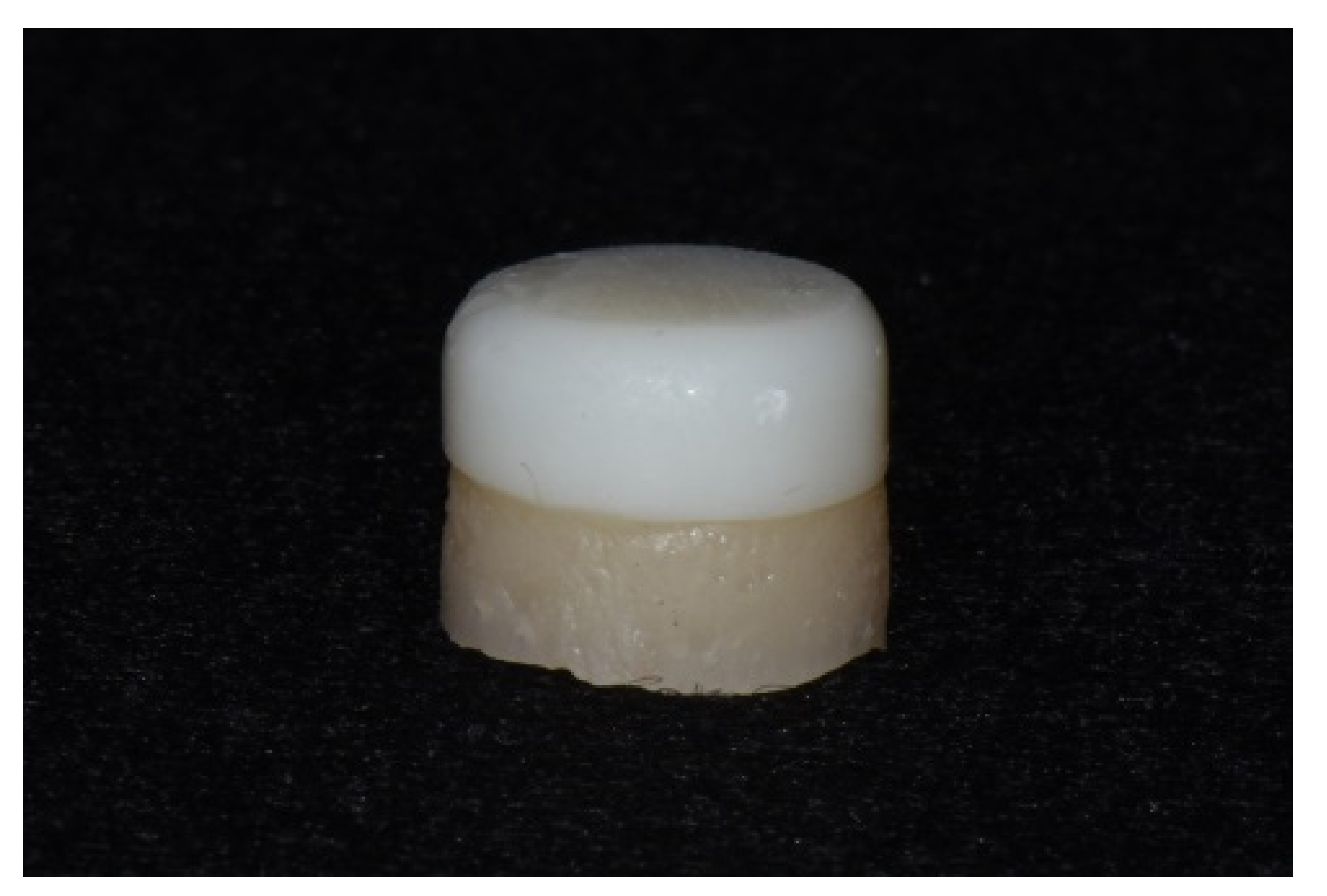

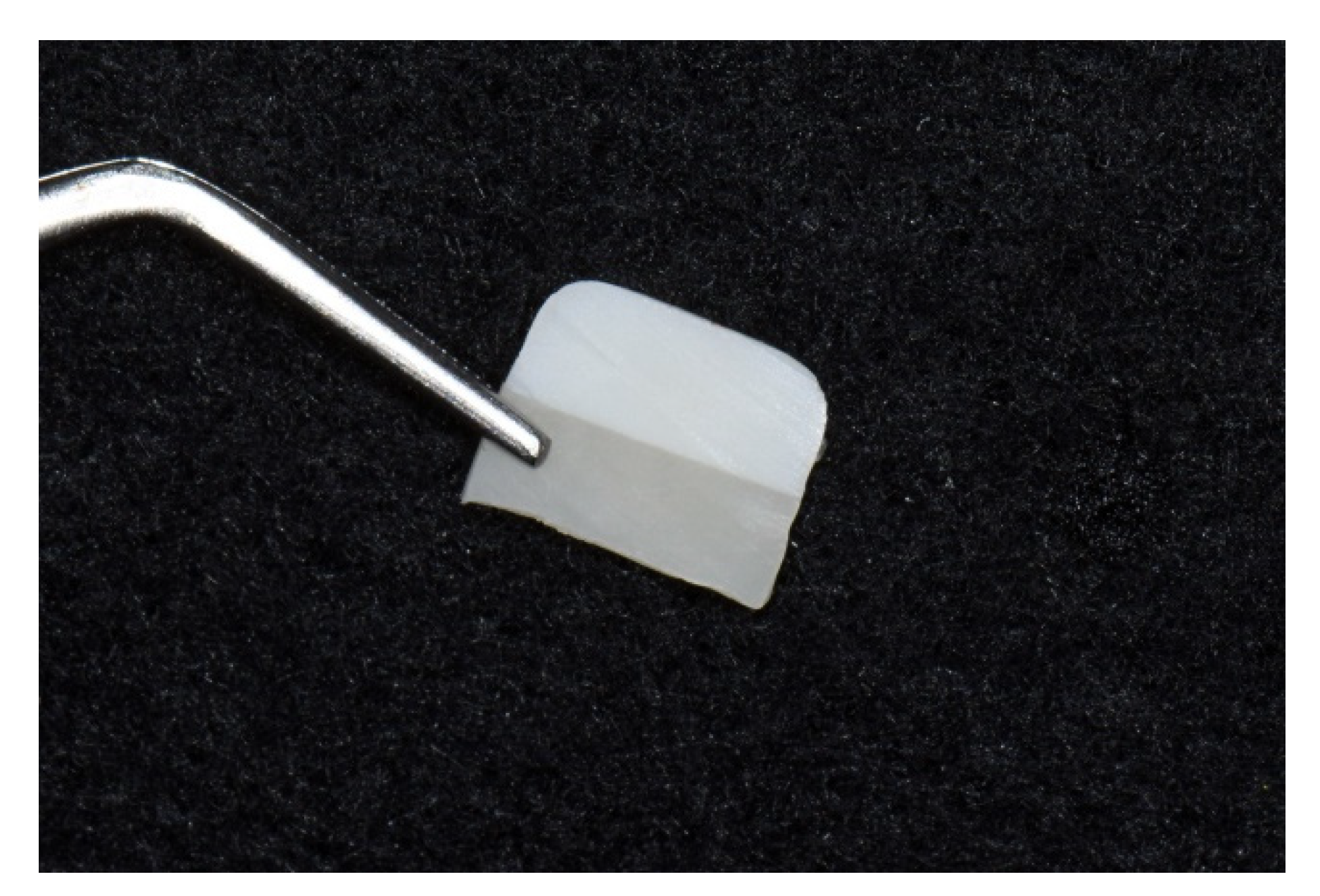
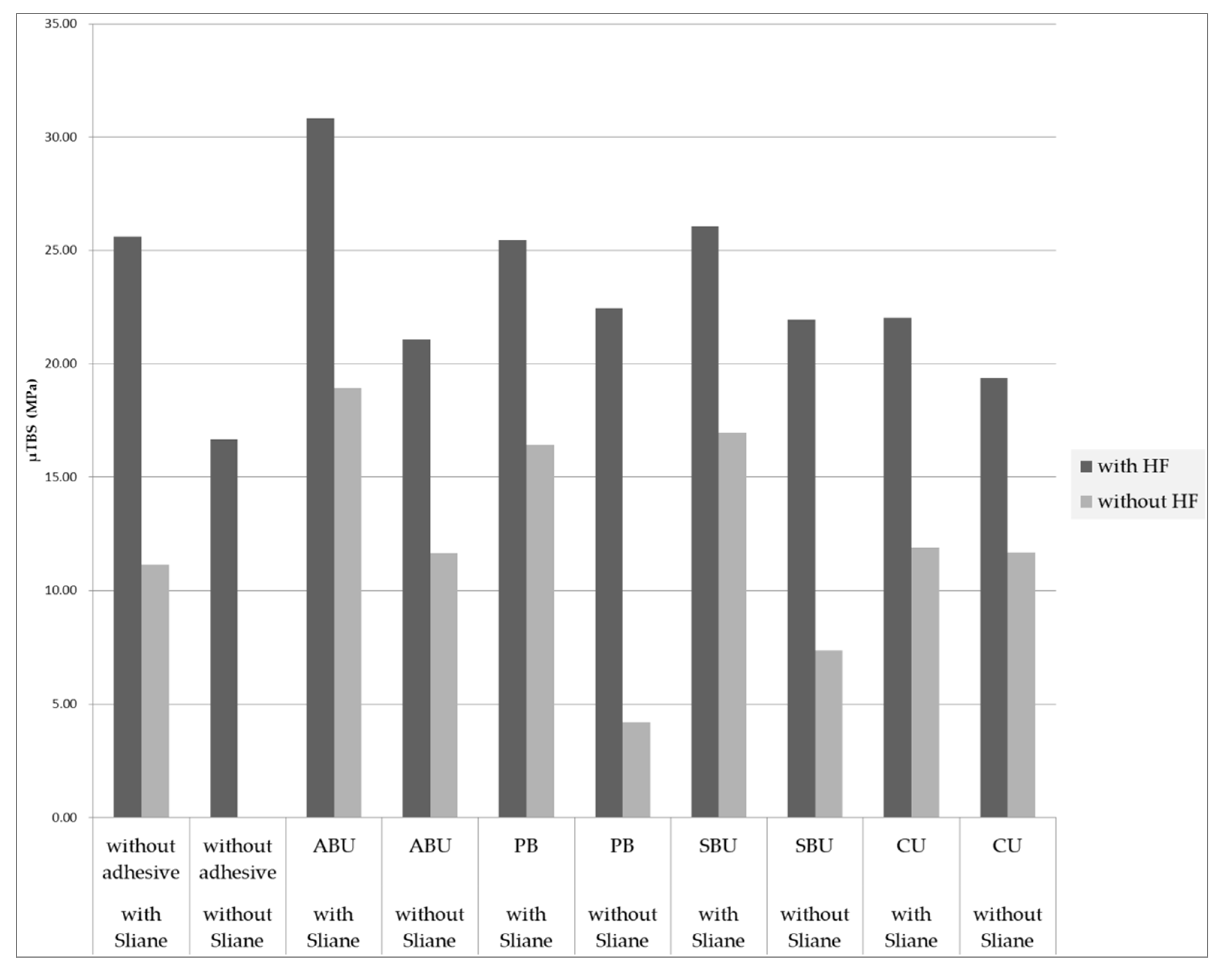
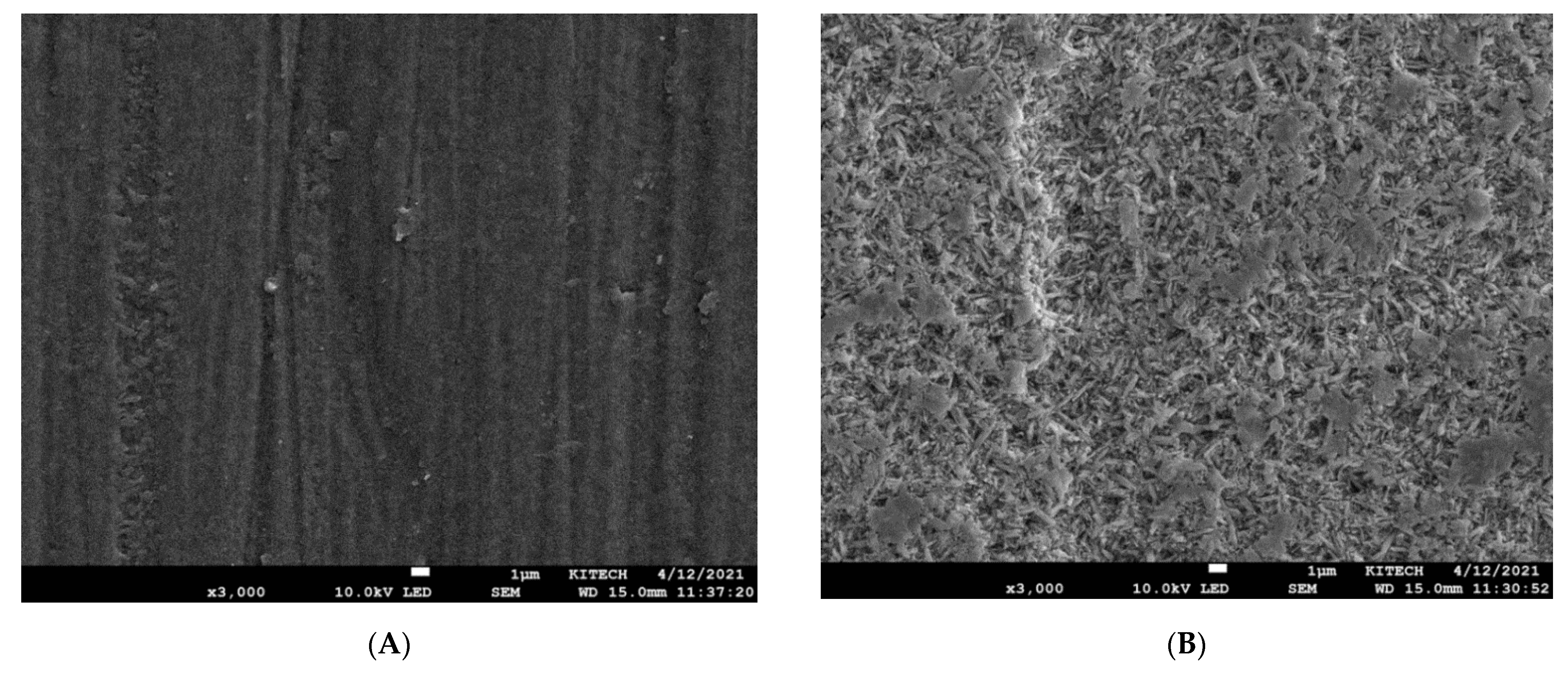
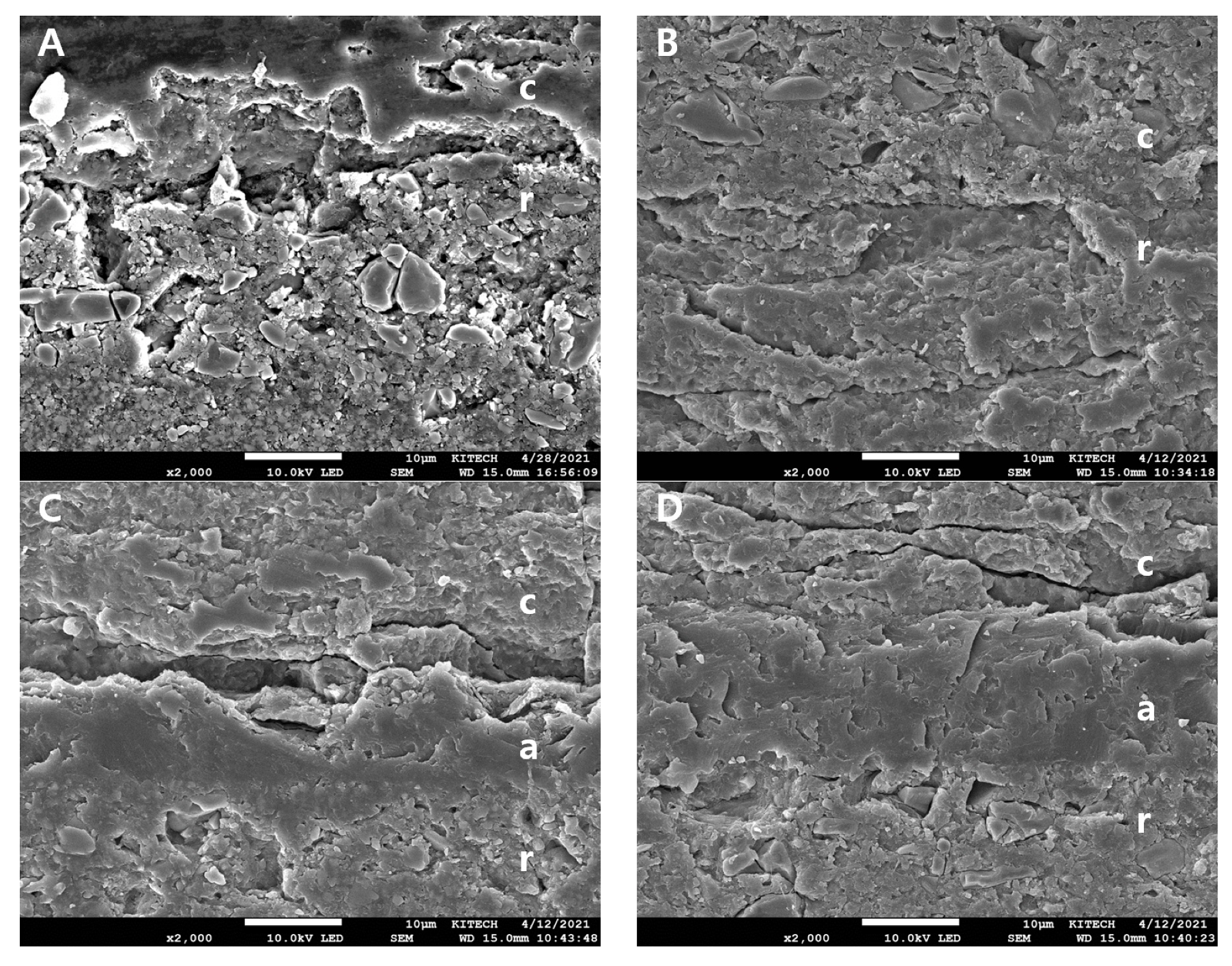
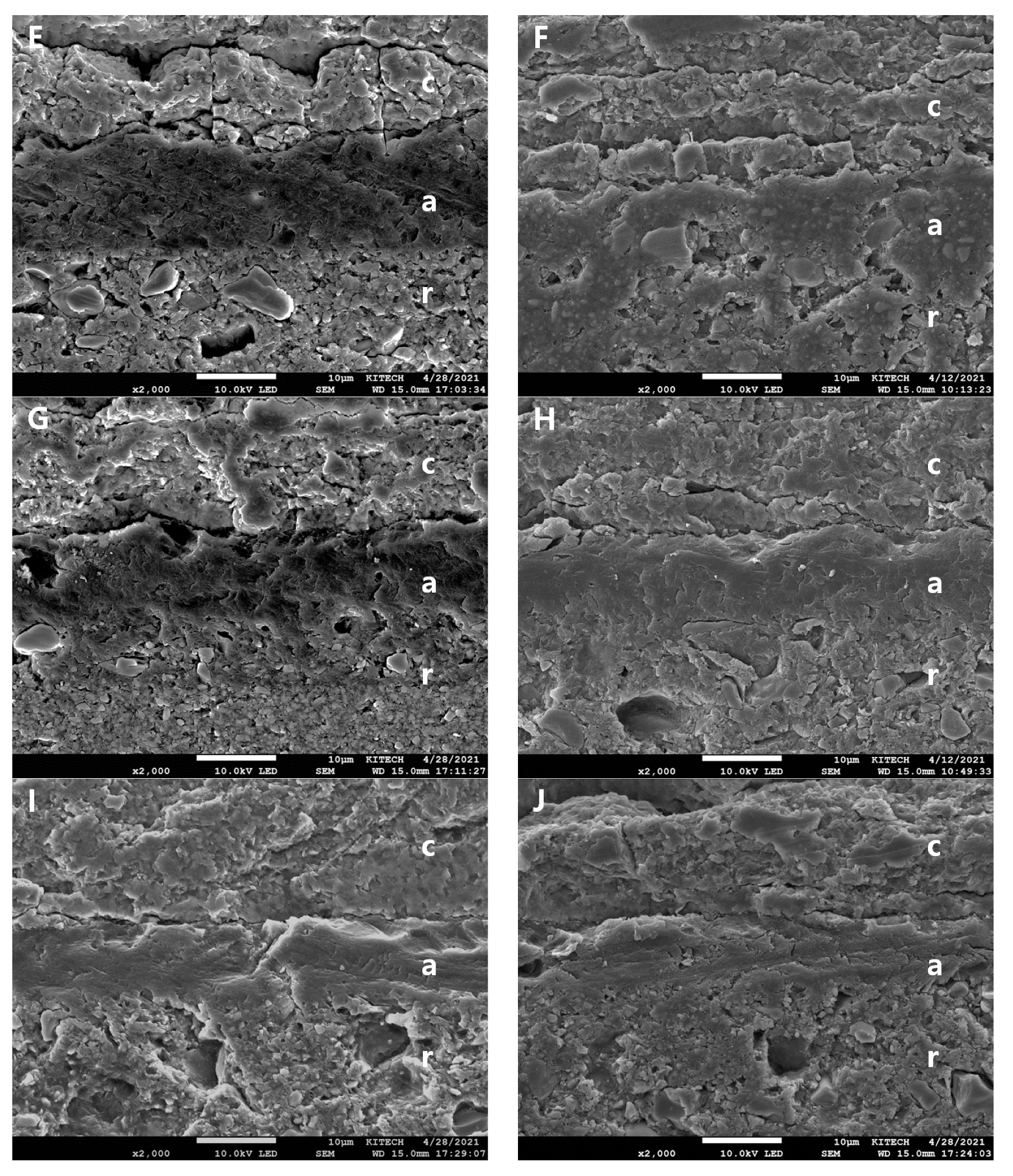
| Universal Adhesive | Abbreviation | Composition | Application Method | pH |
|---|---|---|---|---|
| All-Bond Universal (Bisco) | ABU | MDP, Bis-GMA, HEMA, ethanol, water, initiators | Apply for 10–15 s, mild air-dry for at least 10 s, light cure for 10 s | 3.2 |
| Prime & bond (DENTSPLY Caulk) | PB | MDP, Bis-GMA, HEMA, CQ, MCAP, D3MA, ethanol, water, highly dispersed silicon dioxide | Apply for 20 s, mild air-dry for 5 s, light cure for 10 s | 2.5 |
| Single Bond Universal (3M) | SBU | MDP, HEMA, silane, filler, dimethacrylate resins, water, Vitrebond copolymer, ethanol, initiators | Apply adhesive for 20 s, dry gently for 5 s, light cure for 10 s | 2.7 |
| Clearfil Universal Bond (Kuraray) | CUB | MDP, Bis-GMA, HEMA, CQ, hydrophilic aliphatic imethacrylate, colloidal silica, accelerators, silane coupling agent | Apply for 10 s, mild air-dry for 5 s, light cure for 10 s | 2.3 |
| With HF | ABU | PB | SBU | CU | Without Adhesive |
| with Sliane | 30.82 ± 4.72 b | 25.47 ± 2.75 a | 26.06 ± 3.86 ab | 22.03 ± 4.48 a | 25.61 ± 4.60 a |
| without Sliane | 21.07 ± 3.34 a | 22.45 ± 6.04 a | 21.95 ± 3.58 a | 19.39 ± 4.02 a | 16.67 ± 5.18 a |
| p-value | p < 0.05 | p > 0.05 | p < 0.05 | p > 0.05 | p < 0.05 |
| Without HF | ABU | PB | SBU | CU | Without Adhesive |
| with Sliane | 18.92 ± 5.04 b | 16.44 ± 2.79 b | 16.97 ± 2.77 b | 11.89 ± 2.62 a | 11.15 ± 2.27 a |
| without Sliane | 11.65 ± 3.03 d | 4.21 ± 1.42 b | 7.37 ± 3.36 c | 11.68 ± 2.41 d | pre-failure a |
| p-value | p < 0.05 | p < 0.05 | p < 0.05 | p > 0.05 | p < 0.05 |
| Mixed Failure | Adhesive Failure | |||
|---|---|---|---|---|
| with HF | with Sliane | without adhesive | 0 | 15 |
| without Sliane | 0 | 15 | ||
| with Sliane | ABU | 4 | 11 | |
| without Sliane | 0 | 15 | ||
| with Sliane | PB | 0 | 15 | |
| without Sliane | 0 | 15 | ||
| with Sliane | SBU | 0 | 15 | |
| without Sliane | 0 | 15 | ||
| with Sliane | CU | 0 | 15 | |
| without Sliane | 0 | 15 | ||
| without HF | with Sliane | without adhesive | pre-failure | |
| without Sliane | 0 | 15 | ||
| with Sliane | ABU | 0 | 15 | |
| without Sliane | 0 | 15 | ||
| with Sliane | PB | 0 | 15 | |
| without Sliane | 0 | 15 | ||
| with Sliane | SBU | 0 | 15 | |
| without Sliane | 0 | 15 | ||
| with Sliane | CU | 0 | 15 | |
| without Sliane | 0 | 15 | ||
Publisher’s Note: MDPI stays neutral with regard to jurisdictional claims in published maps and institutional affiliations. |
© 2021 by the authors. Licensee MDPI, Basel, Switzerland. This article is an open access article distributed under the terms and conditions of the Creative Commons Attribution (CC BY) license (https://creativecommons.org/licenses/by/4.0/).
Share and Cite
Kim, Y.-R.; Kim, J.-H.; Son, S.-A.; Park, J.-K. Effect of Silane-Containing Universal Adhesives on the Bonding Strength of Lithium Disilicate. Materials 2021, 14, 3976. https://doi.org/10.3390/ma14143976
Kim Y-R, Kim J-H, Son S-A, Park J-K. Effect of Silane-Containing Universal Adhesives on the Bonding Strength of Lithium Disilicate. Materials. 2021; 14(14):3976. https://doi.org/10.3390/ma14143976
Chicago/Turabian StyleKim, Yu-Ri, Jae-Hoon Kim, Sung-Ae Son, and Jeong-Kil Park. 2021. "Effect of Silane-Containing Universal Adhesives on the Bonding Strength of Lithium Disilicate" Materials 14, no. 14: 3976. https://doi.org/10.3390/ma14143976
APA StyleKim, Y.-R., Kim, J.-H., Son, S.-A., & Park, J.-K. (2021). Effect of Silane-Containing Universal Adhesives on the Bonding Strength of Lithium Disilicate. Materials, 14(14), 3976. https://doi.org/10.3390/ma14143976






